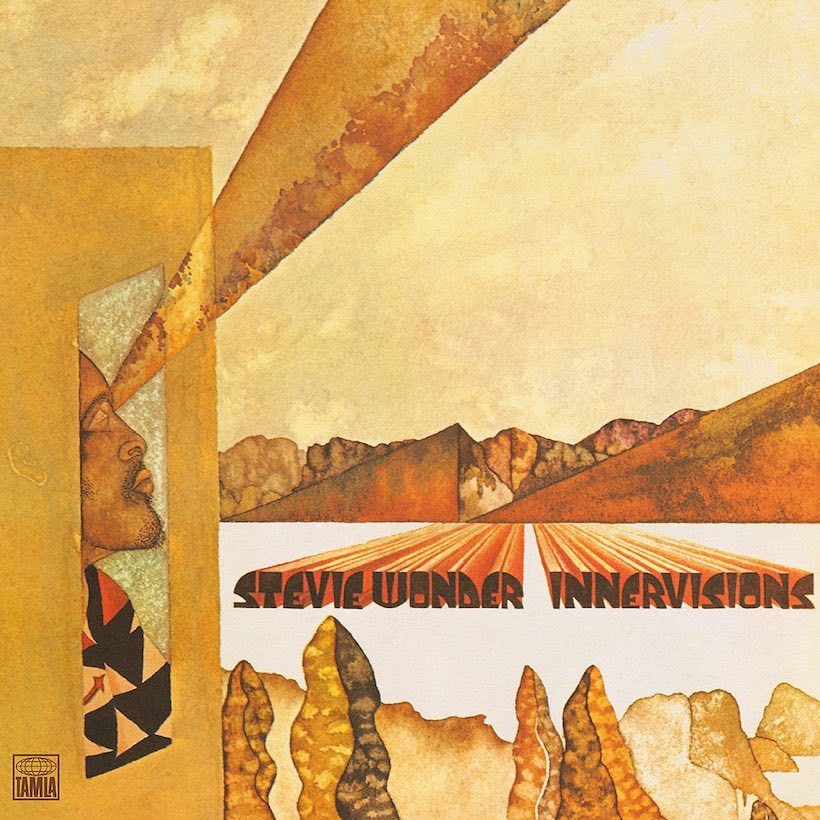When Stevie Wonder Blended Funk, Soul And Social Commentary On ‘Innervisions’
‘Innervisions’ won the Album of the Year Grammy, Best R&B Song for ‘Living For The City,’ and endless reverence ever since.

There may not be many cases in the history of popular music in which an artist’s 16th album is widely regarded as their best to date. But in the red-hot cauldron of Stevie Wonder’s creative streak of the 1970s, anything was possible. On August 3, 1973, an almost impossibly brief ten months after he opened his Talking Book, he returned with another immortal entry to his canon, Innervisions.
By now, the Motown genius was carving musical miracles with such regularity that we had grown to expect, and even demand, them. If Talking Book is regarded as the first chapter of his classic period, then Innervisions was a whole new volume, earning the Album of the Year Grammy, Best R&B Song for “Living For The City,” and endless reverence ever since, including a place in the Grammy Hall of Fame in 1999.
In May 1973, a supernatural jag of inspiration had seen the swift creation of the album’s first single “Higher Ground.” The lyric addressed the weighty topic of reincarnation, but the music, for which Stevie played everything, was effervescently funky, with a bubbling Moog, a wah-wah clavinet sent through a filter pedal and an irresistibly urgent aura. It was the perfect preview of the long player, and rose to become his eighth US R&B No.1, almost exactly a decade since his first with “Fingertips, Pt. 2.”
Wonder almost didn’t live to witness its success, or the rapture that greeted the ensuing album. On August 6, three days after the release of Innervisions, he was in a Mercury Cruiser being driven by his cousin John Wesley Harris on Interstate 85, after a show the night before in Greenville, South Carolina. It was the latest date on a tour that had called at the Newport Jazz Festival the week before.
Listen to the best of Stevie Wonder on Apple Music or Spotify.
Stevie was asleep, wearing headphones, when the car collided violently with a flatbed truck in front of it. Comatose and bleeding, the star was rushed to hospital, where the Jackson 5, who were booked to perform in nearby Greensboro, visited him the next day; messages of goodwill arrived from Paul McCartney, Roberta Flack, and members of Chicago.
After a week in intensive care and another week in hospital, Wonder left to continue his merciful recovery. “What happened to me was a very, very critical thing, and I was really supposed to die,” Stevie told Crawdaddy magazine candidly. Plastic surgery was suggested to remove the mark left by the crash, but he vowed to leave it “as one of the scars of life I went through.”
Wonder confided to Paul Gambaccini in Rolling Stone early in 1974: “With Innervisions, I was going through a lot of changes. Although I didn’t know we were going to have an accident, I knew I was undergoing changes. ‘Higher Ground’ is the only time I’ve ever done a whole track in one hour, and the words just came out. That’s the only time, and that’s very heavy.”
As the poignantly-titled single continued its ascent, Innervisions was greeted with delight. “Stevie identifies himself as a gang and a genius,” wrote Clayton Riley in the New York Times, “producing, composing, arranging, singing and, on several tracks, playing all the accompanying instruments.”
Billboard mused: “In essence, this is a one-man-band situation and it works. His skill on drums, piano, bass, Arp [synthesizers] are outstanding and all the tracks work within the dramatic framework. All the songs are his own creation and they show a deep concern for sketching studies of serious situations.” For all of Stevie’s solo expertise, great credit must also go to the groundbreaking Robert Margouleff and Malcolm Cecil for their programming of the Arp and Moog synthesizers.
In Rolling Stone, Lenny Kaye opined of the album: “Its tracks are coupled by a hovering mist of subdued faith, of a belief in the essential rightness of things; and if he seeks to offer no real solutions (should he?), neither does he allow for any easy outs, any quick glossings of the surface.”
Eric Henderson, looking back on the album in Slant in 2003, observed: “Innervisions was something of a departure because Wonder, who was previously more than content to allow his lyrics, both bitter and sweet, to apply to simple love scenarios, had discovered a desire to tap into a larger reserve of collective emotion – in this case, the disenfranchised rage of America’s Nixon era.”
That rage was very much to the fore on the album’s second single, “Living For The City,” in which a boy is born into poverty (in Mississippi, but it could be anywhere in the openly racist, dysfunctional, and dis-United States that Wonder observed). The brooding track became another R&B No.1 and Top 10 pop crossover, and was followed at 45rpm by the equally breathtaking “Don’t You Worry ’Bout A Thing” and “He’s Misstra Know-It-All,” the latter with bass by Willie Weeks.
Elsewhere, in the most damning lyrics of his young life, he denounced the “superficial paradise” of drugs on “Too High,” religious corruption on “Jesus Children of America,” and shameless hatred on “Visions.” But a fully rounded LP also offered tender sketches of passionate love (“Golden Lady”) and heartbreaking loss (“All In Love Is Fair”).
Innervisions went to No.4 pop and spent two weeks atop the Billboard R&B chart, taking over at No.1 from Touch Me In The Morning, by Stevie’s friend and Motown labelmate Diana Ross. The impact of the album was far-reaching and immediate, as Lenny Kravitz told Q magazine in 1995.
“Stevie Wonder really hit me when I was eight years old,” he said. “I was hearing the production, all the different instruments. I knew all the parts on this album. I could hum you the Fender piano part, the mini Moog part, the drums – everything! It was so musical, so soulful and it also had a very spiritual feeling.”
Recently named one of Apple Music’s Best 100 Albums Of All-Time, listen to Innervisions now.












